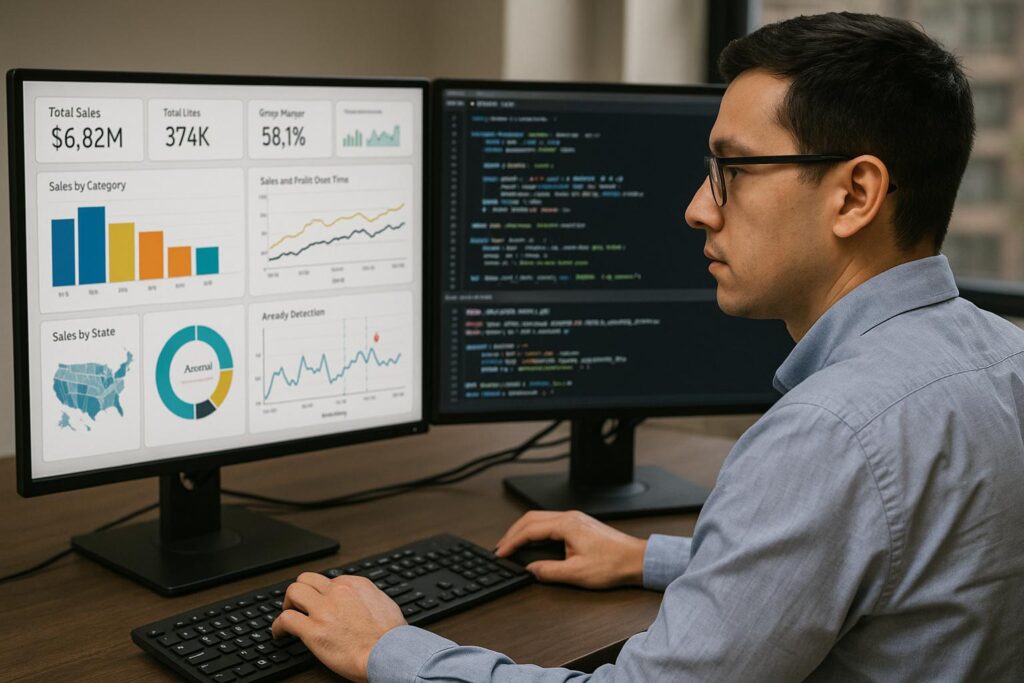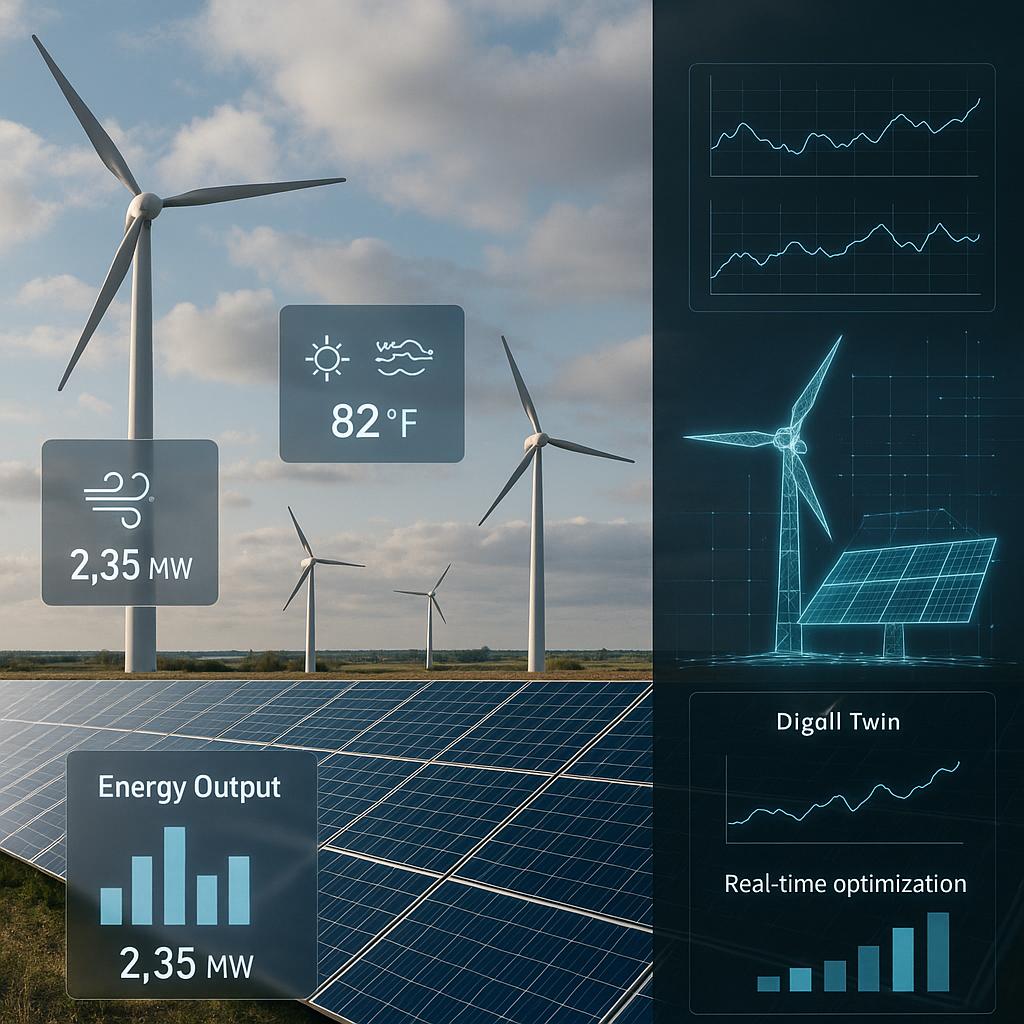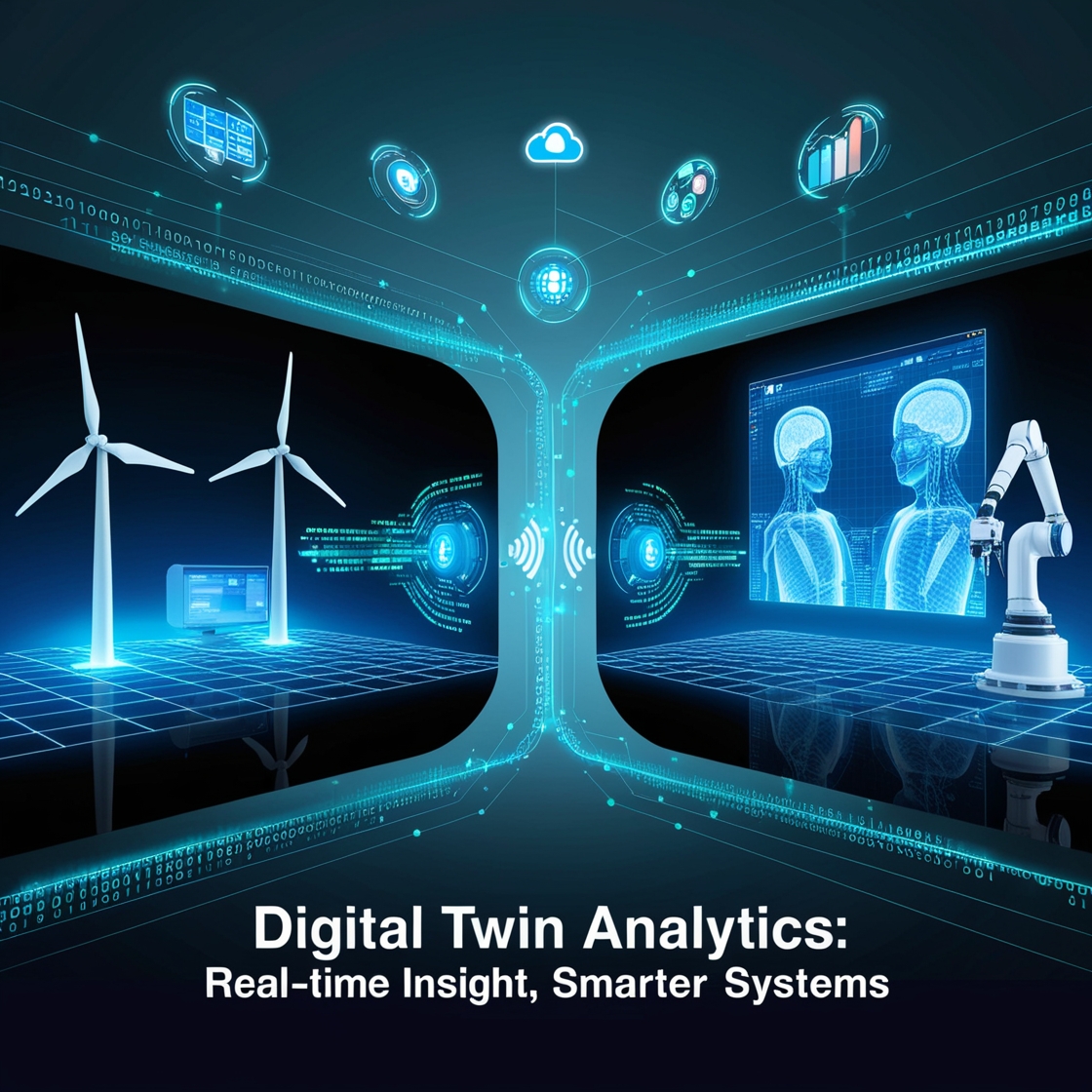Introduction
How businesses operate, innovate, and compete has changed as a result of the growing need for automation, real-time data, and smarter operations. Manufacturing, healthcare, logistics, and energy are among the industries that are always looking for tools that can not only simulate but also anticipate and improve real-world processes. Digital Twin Analytics, which combines virtual models with sophisticated data analytics to monitor, simulate, and optimize physical assets and processes, is a ground-breaking solution to this problem.
The integration of IoT sensors, cyber-physical systems, and intelligent data-driven feedback loops forms the core of Digital Twin Analytics. By continuously receiving real-time data from its physical counterpart, a digital twin functions as a real-time digital reproduction of a physical object or action. Businesses may anticipate problems, test remedies online, and enhance performance with amazing accuracy by implementing data analytics, which includes predictive maintenance, machine learning models, and scenario analysis.

An expert data analyst‘s contributions are essential to this procedure. Every second, enormous amounts of sensor-generated data enter digital twins, necessitating experts in data cleaning, organization, analysis, and visualization. By converting these unprocessed inputs into actionable insights, a data analyst helps decision-makers cut waste, improve operational efficiency, and quickly adjust to new circumstances.

Another potent characteristic of Digital Twin Analytics is the ability to simulate “what-if scenarios”. Without interfering with ongoing business operations, organizations can investigate possible outcomes like equipment failures, abrupt changes in demand, or environmental disturbances. This strategy, which is backed by cloud computing and automated models, enables industries to make more educated, lower-risk decisions based on data and analytics.
A closer look at how Digital Twin Analytics is transforming industry operations is provided in this article. We’ll examine the factors propelling this cutting-edge field ahead and examine why it’s emerging as a key component of digital transformation initiatives, from its technological underpinnings to the function of data analysts, and from cross-sector applications to quantifiable advantages.
Background
In order to assist engineers in creating virtual representations of actual systems for testing and monitoring purposes, particularly in settings where direct access was restricted, such as space missions, the idea of a digital twin first surfaced in the early 2000s. As IoT sensors, cloud computing, and machine learning advanced over time, the concept gained applicability well beyond its initial setting. By continuously feeding operational data into a digital copy, digital twins are being used by sectors such as manufacturing, healthcare, energy, and logistics to gain a better understanding of how their assets function in real-world scenarios.
The use of data analytics was what really made digital twins reach their full potential. This transformed them from static models into dynamic systems that can simulate future events and suggest courses of action in addition to reflecting the present. Digital twin analytics, which uses insights from historical and real-time data to help organizations anticipate problems, enhance performance, and test ideas in a virtual environment before implementing them in real life, emerged as a result of this evolution. Businesses can now be more proactive, flexible, and effective thanks to this change, particularly when led by a qualified data analyst who can transform unstructured system data into strategic decisions.
How Digital Twin Analytics Works
1- Information Gathering
Physical assets with sensors built in gather data in real time (e.g., temperature, speed, pressure, vibration). This is true for all industries, from the turbines in renewable energy projects like wind farms and solar panels to the machinery on a factory floor.
2- Electronic Representation
A digital replica is fed this data, which updates its behavior and state on a constant basis. The twin represents real-world situations as they change, whether it’s a wind turbine, a manufacturing line, or a logistics center.
3- Processing Analytically
Advanced methods such as machine learning, visualization, predictive modeling, and descriptive analytics are used for:
-
Find irregularities (e.g., sudden energy decreases, system breakdowns)
-
Project future occurrences (such as equipment wear or peaks in energy demand)
-
Model a range of operating scenarios, such as resource constraints or electricity output in various weather conditions
4- Making Choices
Operators can either manually use the insights or have them automatically sent back into the system for action (e.g., scheduling maintenance or altering parameters). This could entail lowering wind turbine stress at times of heavy load or improving solar panel angles in the context of Renewable Energy.

Applications Across Industries
Digital twin analytics has a wide range of high-impact use cases:
-
Manufacturing
Predictive maintenance for machinery, production line optimization, and energy consumption reduction. -
Healthcare
Patient-specific twins for testing treatment options or simulating organ functions for surgery planning. -
Energy and Utilities
Monitoring and optimizing power grid operations, predicting failures in wind turbines or pipelines. -
Smart Cities
Simulating urban mobility, environmental impact, and emergency responses using city-wide digital models. -
Logistics and Supply Chain
Enhancing real-time tracking, reducing bottlenecks, and optimizing delivery routes.
Benefits of Digital Twin Analytics
-
Predictive Power
Prevent failures before they happen and reduce unplanned downtime. -
Enhanced Efficiency
Data-driven optimization of processes and resources. -
Scenario Testing
Evaluate multiple “what-if” strategies without real-world risk or cost. -
Improved Decision-Making
Real-time insights for faster and more accurate choices. -
Sustainability
Reduce waste and energy use through continuous monitoring and adjustment.

Challenges and Considerations in Digital Twin Analytics
-
Data Integration Complexity
Combining real-time, historical, and structured/unstructured data from diverse sources is technically demanding. -
High Initial Costs
Developing and maintaining a full-scale digital twin ecosystem requires significant investment. -
Security & Privacy Risks
Constant data exchange increases the attack surface for cyber threats. -
Model Accuracy and Validation
Inaccurate digital models can lead to misleading insights or wrong decisions.

Conclusion
Digital Twin Analytics is a fundamental rethinking of how we watch, manage, and enhance the systems around us, not just a technical advancement. Real-time data from physical assets and virtual models is combined in this way to provide a level of operational visibility and responsiveness that is unmatched by conventional techniques. As a digital link between the real and virtual worlds, it continuously converts current events into intelligence that may be put to use.
Digital Twin Analytics‘s capacity to do more than just monitor, predict, simulate, and even automate is what makes it particularly potent. Predictive modeling, descriptive analytics, and machine learning are examples of advanced data analytics techniques that help businesses identify possible failures before they occur, test “what-if scenarios” without interfering with actual operations, and continuously adjust to changes in weather, demand, or equipment performance. This is especially helpful in fast-paced industries like manufacturing, shipping, and renewable energy, where dependability, efficiency, and punctuality are crucial.
At the heart of this change is the function of the data analyst. The task of converting the vast amounts of data that digital twins gather from IoT sensors and linked devices into understandable, strategic insights falls to qualified experts. A data analyst not only makes sure that the data is correct and organized correctly, but they also develop models and visualizations that provide decision-makers increased confidence. Digital Twin Analytics is intelligent, responsive, and not only automated because of this human component.
Although there are still challenges, like the intricacy of data integration, upfront expenses, and privacy issues, the long-term advantages are significant. Digital Twin Analytics is emerging as a key component of smart systems and infrastructure that is prepared for the future, offering benefits such as better resource planning, less downtime, predictive maintenance, and sustainability enhancements. Thanks to the insights of cutting-edge technology and the expertise of data-driven professionals, the gap between data and action is getting smaller as more firms adopt this strategic change.


